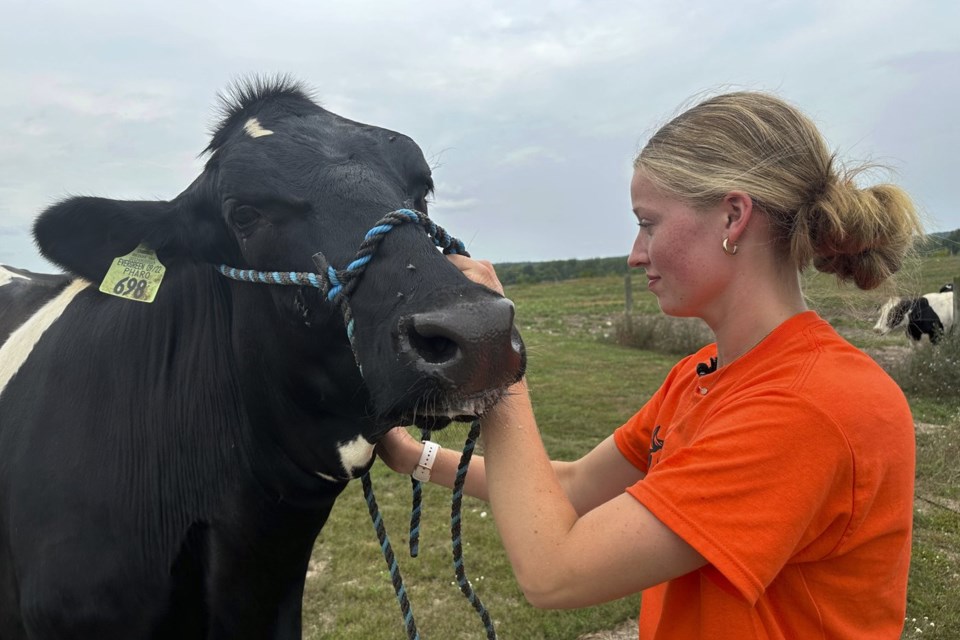EVART, Mich. (AP) — Alison Smith stared at the virtually empty dairy barn inside the Osceola County Fairgrounds, once bustling with teens and preteens preparing to show their prized animals but now eerily silent as an invisible virus once again interfered with a cherished summertime rite.
Smith, a 16-year-old from the Grand Rapids, Michigan, area, had invested a significant amount of time over the past year preparing two heifers, Evergreen and Perfect, for competition at the fair. But like hundreds of fairs nationwide, a recent , now spreading among mammals, forced significant changes — or outright cancellations — of the livestock contests that are a hallmark of summer fairs.
“Normally, we have a million cows in here,” Smith said. “And just a lot of people talking and having fun catching up in the dairy barn.”
States have tightened restrictions on dairy cows following the bird flu outbreak that has spread to millions of poultry flocks nationwide and across 13 U.S. states since March. also have been infected this year, with all experiencing relatively mild symptoms.
The risk to humans from the bird flu virus remains low, according to the federal Centers for Disease Control and Prevention.
The virus has further strained businesses already battered by pandemic disruptions, leading to millions of dollars in losses and worker layoffs. Michigan’s largest egg producer, Herbruck’s Poultry Ranch, laid off close to 400 employees following an outbreak of bird flu at their farms.
It also has disrupted long-standing family traditions, such as those cherished by Smith, who has been exhibiting heifers, cows, pigs and dairy steers at fairs for a decade.
"Unfortunately, this will be my second year that I haven’t been able to show because of COVID in 2020. And then this year the bird flu,” Smith said.
When Jacob Stieg, the Osceola 4-H coordinator, sent out an email detailing the state’s limits on showing lactating cattle at fairs, Smith’s reaction was, “Oh, my gosh. This is another year that I can’t show.”
“It’s kind of sad, really. I miss it a lot and all the memories we’ve made in this barn,” Smith added, pointing to the now-empty stall where her cow, Extraordinaire, was housed last year. She won the Supreme Grand Champion award a year ago at the fair held just under three hours northwest of Detroit.
“I was trying to think of the positives,” she said. “I couldn’t really find any.”
Michigan has been among the hardest-hit states, with infected and 27 livestock herds affected.
The state ordered strict testing and public health measures, including banning the exhibition of lactating dairy cattle and those in the final two months of pregnancy until Michigan dairy cows have gone 60 consecutive days without new bird flu cases. All other cattle must test negative within seven days before being shown.
The restrictions didn’t outright ban dairy cattle shows at fairs, but some in the state opted to cancel the competitions, according to Kendra Van Order, the 4-H dairy science educator for Michigan State University Extension.
Fairs in other states have made changes to try to lessen the chances of flu spreading among livestock, or to people.
In some states, including Iowa, Wisconsin and Minnesota, lactating dairy cows are still allowed at fairs, but only if they have proof of negative flu tests in the week before they arrive.
The at the Minnesota State Fair excluded birthing cows and newborn calves from the popular exhibit as a precaution against bird flu. Iowa’s state fair canceled two attractions, a milking parlor and an “I Milked a Cow” experience that let people interact with lactating cows.
In July, fair exhibitors and organizers take steps to protect livestock and people, including limiting animals' time at fairs and avoiding direct contact with animals when possible. That came on the heels of stressing testing and biosecurity measures.
Van Order, who coordinates with fairs through her role at Michigan State, grew up exhibiting beef cattle and sheep at local, state and national gatherings. Caring for livestock requires daily commitment, “whether it snows, it rains, or if they’re sick," she said.
Owning and exhibiting livestock "teaches young people to care for things other than themselves,” Van Order said. “A lot goes into it. And just that drive of wanting to be competitive and do something that you really love to do, to have that opportunity maybe not be there can be very heartbreaking.”
But part of life, Van Order said, is about dealing with disappointment. Working with fairs across the state, she and her team developed a list of alternative activities that local fairs could offer in place of traditional showings. They include quiz bowls, photography contests and recorded showmanship.
Though the alternative activities helped bring competitors together, it’s “not the same,” Smith noted. Youth can participate in 4-H activities up until age 19 and with only a few years left before she ages out, Smith hopes 2025 will be different.
“I’m not sure what’s going to happen next year. I assume they’ll have a better idea of what to do about the dairy, and hopefully, they’ll let us come back, but it’s probably going to be around next year,” she said. “So, just like COVID, I don’t know what next year’s going to hold.”
___
Cappelletti reported from Lansing, Michigan.
Joey Cappelletti And Mike Householder, The Associated Press




